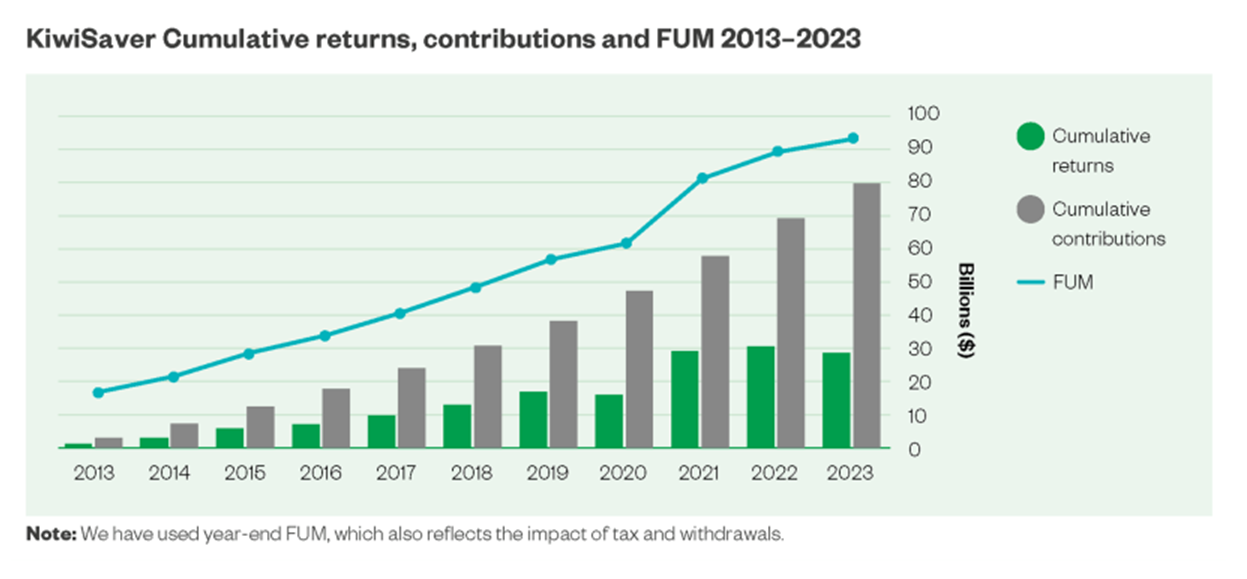The scheme grows by $4 billion this year

KiwiSaver has remained resilient through a period of market volatility, with total funds in the voluntary, work-based retirement savings scheme growing by $4 billion this year and with total membership growing by around 3% to 3.25 million investors, according to the FMA.
The FMA’s latest KiwiSaver Annual report for the year to March showed the $4 billion gain was due to contributions of $10.5 billion from members, employers, and government, and despite the $1.9 billion in investment losses at the March year end.
This was the fourth time total investment returns have dropped in the scheme’s 16-year history, but with investment markets having been fairly buoyant since March, some people will now have recovered those losses.
Read more: KiwiSaver Annual Report 2023
Growth funds hit $40 billion
The report showed the total money in KiwiSaver has increased to $94 billion, from $62 billion in 2020, and was six times the total compared to 2013. Money in growth funds breached $40 billion this year, increasing the size of those funds since 2020 by double, while assets in single-sector funds labelled, “Socially Responsible,” hit $1 billion for the first time.
Fee revenue drops
For the first year since 2007, total fees have not increased, with 664.1 million, or 8.1%, deducted from total fee revenue. This decline was due to the combined effect of lower default fund fees, reductions in management fees by larger providers, some providers removing fixed membership fees, and others not earning the same level of performance fees.
Administration fees charged this year were the lowest ever. At $17.3 million, they were down 65.7% from last year’s $50.3 million, and 81.2% lower than their peak of $91.8 million in the year to March 2019.
In a media release, John Horner (pictured above), FMA director markets, investors, and reporting, said this was an important milestone, as the authority has been encouraging providers to inform their members about the economic benefits of scale, through its value for money work.
“Reducing fees is a meaningful way to do this, because members retain more in their balances to benefit from compounding returns, but value for money is not just about fees,” Horner said. “We will continue to work with supervisors to ensure managers demonstrate their value-add to members. The value-add should include investment and risk management competence which contributes to members’ balances, and advice which helps members make good decisions.”
Changing investment profile of KiwiSaver
The overall investment profile of KiwiSaver has leaned towards growth over the past three years, fuelled by more investors making active choices and the change in default settings from conservative to balanced, the report said.
There were now less people in conservative funds, from 35% in 2020, to 21%. Those in balanced funds, meanwhile, increased from 21% to 30%, with a third of those accounting for members in the new default fund. Selection of growth funds has lifted from 33% to 37% in the last three years.
Analysing the data over a 10-year period revealed a complete reversal of the earlier preference for conservative, over growth funds. Relative to FMA’s 2013 KiwiSaver Report, 40% of investors were in conservative funds (including default funds) and 23% were in growth. The proportions are currently at 21% (noting default funds are now balanced) and 37%.
Horner said the report, when compared to those from previous years, showed how investor behaviour has changed over time, along with the profile of the funds being selected.
“The FMA has said for some time that younger investors should consider funds with more growth assets, as these are more suited to a longer investment horizon,” he said. “As investors become more comfortable with the long-term nature of KiwiSaver, there has been a major shift towards more growth-oriented funds over the last 10 years.”

Download the KiwiSaver Annual Report PDF.
Get the hottest and freshest mortgage news delivered right into your inbox. Subscribe now to our FREE daily newsletter.



